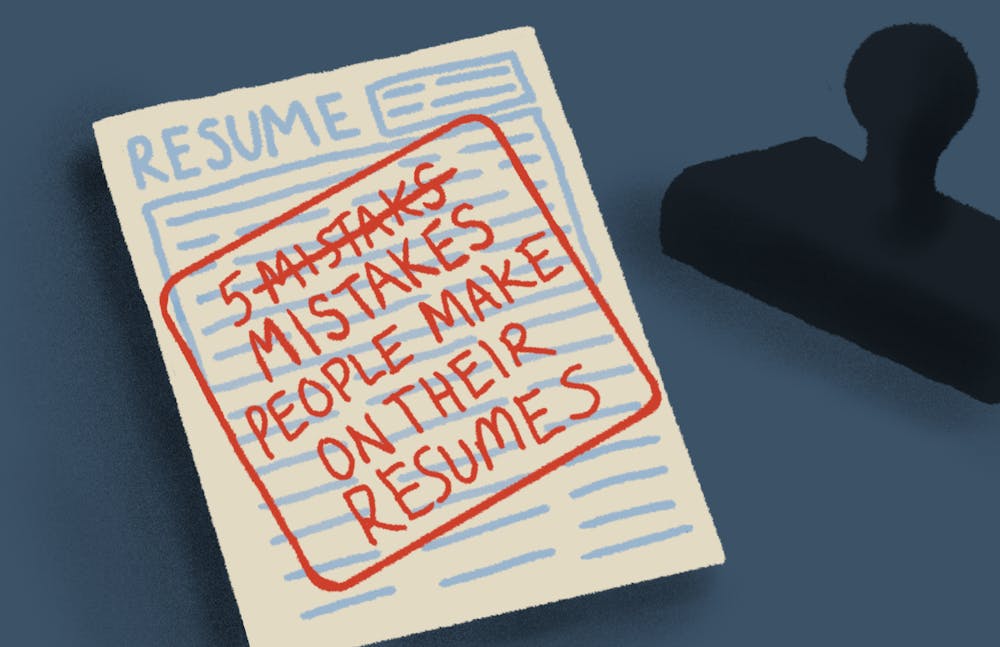Creating a solid resume can make or break someone’s opportunity to get a job. Resumes are the first look employers get at potential employees.
From not proofreading a resume before sending it to an employer to using confusing formatting, these are just a few reasons a resume isn’t chosen over others.
Here are five common mistakes people make on resumes and how to avoid them.
Including unnecessary information
Resumes are typically a one-page document that highlights key experience and qualifications associated with the job you're applying for. Given the limited space you have to make an impression, including excess information will take away from what employers are looking for, said Audrey Cohen, a fourth-year management information systems major at Western.
In an email with Mindy Pelton, director at Western Washington University’s Career Services Center, she provided a few unnecessary items to look out for: “References, high school diploma and associate degree, street address, picture of themselves and irrelevant information (not related to the position).”
When creating a resume, applicants should instead look to include the following: name, contact information, career focus, key skills, education and relevant experience. Experience can take forms such as full-time or part-time work, internships, volunteering, club membership, leadership roles and class projects, Pelton said.
Using confusing formatting
Formatting can make or break a resume. Having a hard-to-read format can be an immediate deterrent for employers, leading them to throw out an application before even looking at it.
“There's a very classic resume template with a big name at the top and then education experiences, skills, all that stuff,” said Cohen. “Which for me is the best because it's straightforward and you have a lot of space to put information down.”
Simple resumes are easy to understand but might not be for everyone. For more resume formats, look at Indeed’s recommended designs at “Top Resume Formats: Tips and Examples of 3 Common Resumes.”
Applicant Tracking Systems, an artificial intelligence system employers use to sort resumes, are also likely to discard your resume if the format is confusing, said Laith Mahmud, a member of Western’s Alpha Kappa Psi fraternity. Alpha Kappa Psi is a fraternity open to all genders and is focused on future life skills, including resume building and how to interview well.
Hiding important information at the bottom of your resume
When organizing your resume, it’s important to include “important” information near the top.
“I think the main rule I follow is just formatting it by relevance,” Mahmud said. “Just what you think is most relevant at the top and least relevant at the bottom.”
If an employer scans a resume on average for a maximum of 20 to 30 seconds, they are most likely to read only the first few lines. Including important information at the top is more beneficial than hiding it near the bottom, said both Mahmud and Cohen.
Not being descriptive enough when discussing prior experience
Prior experience can help strengthen your resume. By failing to describe an experience well, an employer may completely disregard it.
For college students, prior experience in the field you're wanting to enter might be limited. Still, prior experience isn’t just limited to work experience. When described in a compelling way, anything from what has been learned in classes to leadership roles can show relevant skills for the job you’re applying to.
“At the end of each quarter, it’s a great idea to write down all the things you’ve learned, skills developed, technology utilized outside and inside the classroom,” Pelton said. “This will make drafting your resume much easier.”
Prior experience should include three bullet points describing the role. A great way to format these bullets is with the XYZ formula.
“The XYZ format helps you know where to start,” Cohen said. “X is what you did, Y is how you did it and Z is like the outcome.”
Utilizing the XYZ bullet method and including buzzwords within these bullets can increase your chances at getting an interview. Examples of buzzwords include supervised, motivated, guided, facilitated and etc., according to Indeed’s article, “150 CV Buzzwords To Use When Describing Your Work History.”
Not utilizing your resources
Whether it’s asking a peer to look it over or getting help from professionals to strengthen your resume, getting a second or third pair of eyes to read your resume will help to catch any errors or mistakes.
“Don’t be afraid to ask for help,” Cohen said.
At Western, the Career Services Center provides workshops for resumes as a key, campus-centered tool for help on your resume. The Career Services Center’s next workshop about Successful Interviewing Strategies will be held on Zoom or in person at Old Main 280 on Feb. 22.
Courtney Sipila (she/her) is a campus life reporter for The Front this quarter. She is a second-year visual journalism/marketing major. Outside of reporting on the people of Western, Courtney enjoys playing soccer, video games, and watching movies. You can reach her at courtneysipila.thefront@gmail.com.






